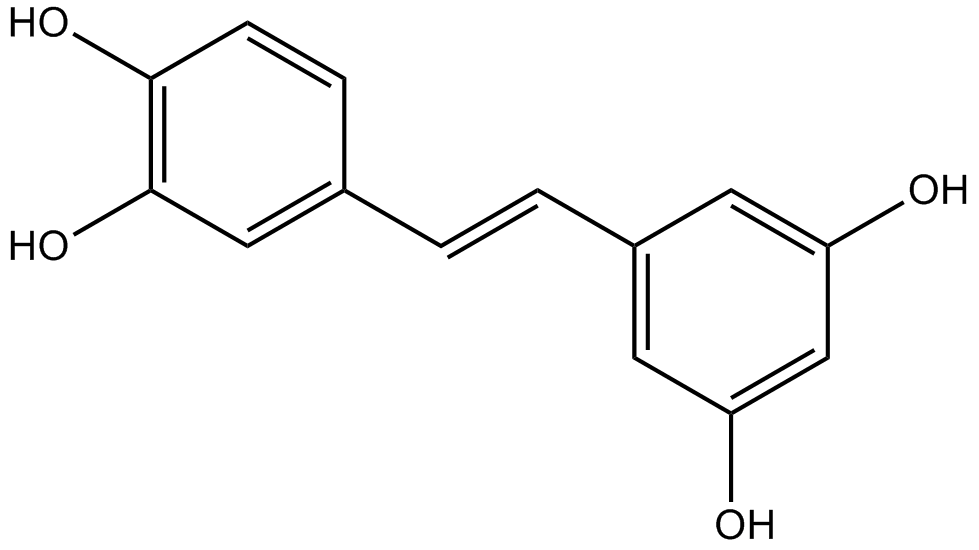Piceatannol (Synonyms: Astringenin, transPicetannol, trans3,3',4,5'Tetrahydroxystilbene) |
| Katalog-Nr.GN10503 |
Piceatannol (3,3′,4,5′-trans-trihydroxystilbene) is a naturally occurring hydroxylated analogue of resveratrol.
Products are for research use only. Not for human use. We do not sell to patients.

Cas No.: 10083-24-6
Sample solution is provided at 25 µL, 10mM.
Piceatannol (3,3′,4,5′-trans-trihydroxystilbene) is a naturally occurring hydroxylated analogue of resveratrol [1]. Piceatannol inhibited mushroom tyrosinase with IC50 value of 1.53 mM [2]. piceatannol is a spleen tyrosine kinase (Syk) inhibitor, it is often used in studies involving Syk kinase-dependent cells [3,4], especially neutrophils [5,6], macrophages [7,8] and smooth muscle cells [9,10].
Piceatannol was used to specifically inhibit Syk, which is an important adaptor of FcγR cross-linking-induced downstream signaling. Application of Piceatannol aborted cyclin D1 expression induced by FcγR cross-linking in murine bone marrow-derived macrophages (BMM) [7]. Pre-incubation of piceatannol (100 nM for 1 h) increased neutrophil adhesion in the presence of E3MPO, reversing the non-adherent phenotype of the cells [5]. piceatannol inhibited Ang II-enhanced rat aortic smooth muscle cells (RASMCs) migration, and inhibited Ang II-stimulated phosphorylation of ERK1/2, p38 MAPK and Hsp27, pretreatment with piceatannol attenuated Ang II-increased sprout outgrowth from aortic rings [9].
Piceatannol (10 or 20 mg/kg/d, 3 weeks, oral) administration significantly decreases solid tumor growth in BALB/c mice injected with 4T1 mammary cancer cells [11]. Piceatannol (20 mg/kg/d, 9 days, oral) inhibits lung metastasis of MAT-Ly-Lu (MLL) cells in nude mice [12].
References:
[1]. Piotrowska H, Kucinska M, Murias M. Biological activity of piceatannol: leaving the shadow of resveratrol[J]. Mutation Research/Reviews in Mutation Research, 2012, 750(1): 60-82.
[2]. Yokozawa T, Kim Y J. Piceatannol inhibits melanogenesis by its antioxidative actions[J]. Biological and Pharmaceutical Bulletin, 2007, 30(11).
[3]. Pavanetto M, Zarpellon A, Borgo C, et al. Regulation of serotonin transport in human platelets by tyrosine kinase Syk[J]. Cellular Physiology and Biochemistry, 2011, 27(2): 139-148.
[4]. Beckmann S, Buro C, Dissous C, et al. The Syk kinase SmTK4 of Schistosoma mansoni is involved in the regulation of spermatogenesis and oogenesis[J]. PLoS Pathogens, 2010, 6(2): e1000769.
[5]. Hayes M J, Cambridge G. An IgM class anti-neutrophil cytoplasm antibody inhibits neutrophil adhesion and apoptosis via a Syk dependent signaling cascade[J]. Molecular immunology, 2004, 41(4): 457-468.
[6]. Ortiz‐Stern A, Rosales C. FcγRIIIB stimulation promotes β1 integrin activation in human neutrophils[J]. Journal of leukocyte biology, 2005, 77(5): 787-799.
[7]. Luo Y, Pollard J W, Casadevall A. Fcγ receptor cross-linking stimulates cell proliferation of macrophages via the ERK pathway[J]. Journal of Biological Chemistry, 2010, 285(6): 4232-4242.
[8]. Gevrey J C, Isaac B M, Cox D. Syk is required for monocyte/macrophage chemotaxis to CX3CL1 (Fractalkine)[J]. The Journal of Immunology, 2005, 175(6): 3737-3745.
[9]. Lau H K F, Ho J. Regulation of plasminogen activator inhibitor‿ secretion by urokinase and tissue plasminogen activator in rat epithelioid‐type smooth muscle cells[J]. British journal of haematology, 2002, 117(1): 151-158.
[10]. Lee H M, Lee C K, Lee S H, et al. p38 mitogen-activated protein kinase contributes to angiotensin II-stimulated migration of rat aortic smooth muscle cells[J]. Journal of pharmacological sciences, 2007, 105(1): 74-81.
[11]. Song H, Jung J I, Cho H J, et al. Inhibition of tumor progression by oral piceatannol in mouse 4T1 mammary cancer is associated with decreased angiogenesis and macrophage infiltration[J]. The Journal of nutritional biochemistry, 2015, 26(11): 1368-1378.
[12]. Kwon G T, Jung J I, Song H R, et al. Piceatannol inhibits migration and invasion of prostate cancer cells: possible mediation by decreased interleukin-6 signaling[J]. The Journal of nutritional biochemistry, 2012, 23(3): 228-238.
Average Rating: 5 (Based on Reviews and 30 reference(s) in Google Scholar.)
GLPBIO products are for RESEARCH USE ONLY. Please make sure your review or question is research based.
Required fields are marked with *




















